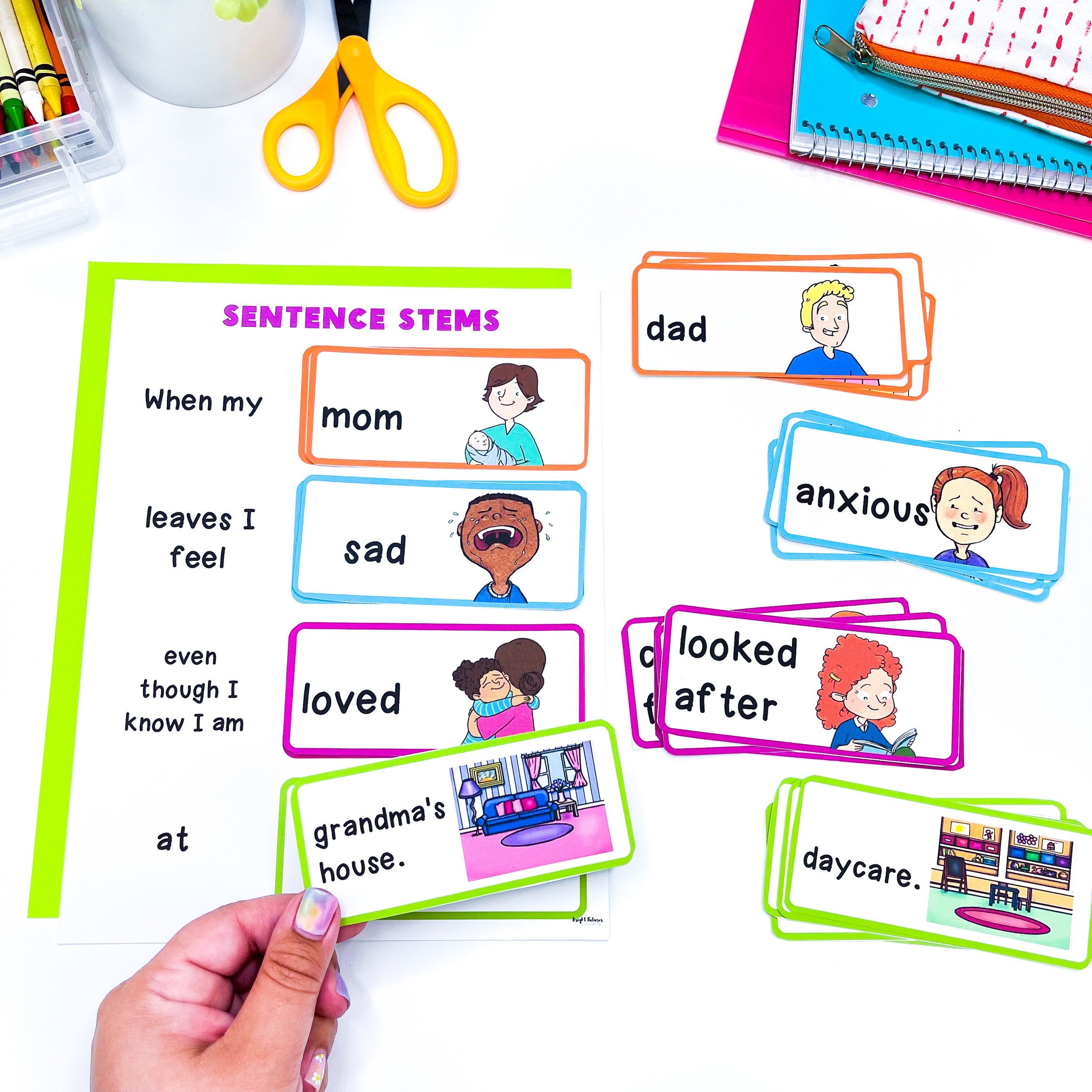Dealing with School Refusal: A School Counselor's Role
By: Neeti Sarkar
I'm sure you've heard this joke before but for the benefit of those who haven't, this has got to be the realest, most relatable teacher joke there is. Here goes:
Early one morning a mother went to her sleeping son and woke him up.
"Wake up, son. It's time to go to school."
"But why, Mama? I don't want to go to school."
"Give me two reasons why you don't want to go to school."
"One, all the children hate me. Two, all the teachers hate me, ..."
"Oh! that's no reason. Come on, you have to go to school!"
"Give me two good reasons WHY I should go to school?"
"One, you are FIFTY-TWO years old. Two, you are the PRINCIPAL of the school."
School refusal. Separation anxiety. Call it what you may, but that season is here! And everybody including your 52-year-old principal is going to expect you to work your magic on these kiddos, simply because you are the school counselor. Am I right or am I right?
So how do you help students combat separation anxiety and school refusal? How can you, as a counselor, support the teachers and the parents of these kiddos? Here are some ideas that have worked for me in the past:
For Students:
1. Organize a school tour
If students struggling with this issue are new admissions, it would help to take away the stress of the unknown by having them take a tour of the school. Familiarizing themselves with the cafeteria, the washrooms, the classrooms, and the playground, can help reduce any stress or anxiety attached to coming to school.
2. Create a safe space
Children are less likely to refuse school when they feel safe at school. The onus of creating a safe space is on all of us at school. However, in your role as the school counselor, you are likely among the first people they will feel safe around. While a 'Calm Corner' in your office is great and you could show them when and how to use it, I suggest working with homeroom teachers to designate and design their own zen zone of sorts where students can go if they feel overwhelmed or anxious during the school day/in case you're not around or available.
3. Offer to check-in
I've often come across families that enable children struggling with separation anxiety. They linger in the hallway, make promises of sticking around and watching their child through the windows, cry when their kid cries during a goodbye that's taken up a good chunk of the first lesson, and then ask you for your personal number so they can call and check on their child throughout the day.
Instead of dealing with this ordeal, offer to check in with the child at the start and/or at the end of the day for a minute meeting to ease them into the day/get an idea of how good the day was. Just the thought of being able to see your kind smile every morning helps both parents and child feel less stressed. You don't have to keep this going through the year. Wean them off this accommodation when you think the child is better settled. At some point, the child doesn't need to come to you. They can just give you a thumbs-up when you walk by their classroom or when they pass your office. Sticker charts are another positive way to encourage attendance.
4. Help them develop a safety plan
As you build rapport with the child, if you still see recurring incidents of school refusal or separation anxiety, I would suggest collaborating with the student to create a personalized coping plan or safety plan to manage stress/worry/anxiety at school. The plan could incorporate relaxation strategies such as deep breathing exercises or progressive muscle relaxation, a list of safe adults to talk to, and practices that can be used at home too to be better prepared for school.
5. Provide additional support
While most students settle in a few weeks into the school year, there may be some that need additional support. Consider running small group counseling sessions for these kiddos if you have 2-3 others also struggling with separation anxiety. Using visualization techniques, social stories, mindfulness, and CBT-based activities have proved useful, in my experience.
For Teachers:
1. Set up a buddy system
It would be helpful to work with the student's homeroom teacher to establish a buddy system where the anxious child is paired with a supportive peer. The latter's presence can provide a sense of comfort and confidence, thereby encouraging the former to interact more with their other peers. Knowing they have someone at school to sit next to or to play with during recess, can help children combat stress/anxiety related to coming to school.
2. Use a visual schedule
Children are creatures of habit and not knowing what to expect can sometimes disturb the emotional wellbeing of some children. Encouraging teachers to use a visual schedule in their classroom would ensure students who struggle with school-related anxiety feel more in control, knowing there is structure and predictability to their school day.
3. Embed SEL in morning circle time
As you know, circle time and morning meetings help create a safe space and promote the building of relationships and a positive classroom culture. Embedding SEL prompts or read-alouds are a great way for teachers to help ease the qualms of students who don't like coming to school and who find saying goodbye to their parents difficult. Some effective read-alouds that teachers can use to address this issue include The Invisible String by Patrice Karst, First Day Jitters by Julie Danneberg, and A Letter from Your Teacher: On the First Day of School by Shannon Olsen.
4. Create classroom jobs
Most often, when students are given responsibilities, they take them seriously. The 'job' might make them feel good about themselves and even help them know that their teachers see and need them. Students who are given responsibilities they like and are comfortable with, are likely to look forward to coming to school, at least to do their 'job'. In the meantime, however, such students gain more confidence and tend to become more independent and responsible.
5. Make reasonable accommodations
One of the most effective accommodations that can be made for children who have a tough time leaving their parents and coming into school is allowing them to bring a transitional object along. Usually, it's a favorite stuffed toy. Sometimes it's a ping-pong ball. I've even had one student bring a packet of crackers in each morning not because she wanted to eat it right away but because she just felt more calm having it in her hand.
For Parents:
1. Validate feelings
When a child is throwing a fit and does not want to go to school, or finds new excuses every day to not go to school, instead of giving in to the tears and tantrums, parents need to be reminded to stay calm and listen to their child. Encourage parents to validate the feelings of their child and to keep communication open. This helps children know they are seen and heard.

2. Establish and follow routines
As you might testify too, a lot of times, kids who refuse school or have a hard time saying goodbye to their parents either haven’t had enough sleep, haven’t eaten, or have simply had their schedule disturbed. Encouraging parents to establish and consistently follow routines at home is something I’d recommend you do.
3. Practice separation
If you encounter children who get overwhelmed and distressed when having to be separated from their parents, you could encourage the parents to practice separation for smaller periods and in contexts other than school too. Gentle exposure works for a good number of kiddos.
4. Make goodbyes quick
One of the biggest struggles I’ve witnessed is the power struggle between parent and child at the drop-off point in school. While validating the parent’s feelings, I ask them not to linger, to say goodbye as quickly as possible, and to trust the child’s teacher to take care of the child. Another thing you might have to do is discourage parents from making false promises of sticking around or even discourage them if they think it’s okay to slither away without a goodbye, which would potentially create distrust between their child and them.

5. Be positive role-models
Kids feed off their parents' energy and emotions. As counselors, we need to encourage parents to show enthusiasm and positivity about the new school/school year. Speaking well of the school and talking about it positively might help an anxious child feel less worried about going to school.
Starting a new academic year can be daunting, no matter if you are a counselor, a teacher, a parent, or a student. Overcoming challenges related to separation anxiety and school refusal requires patience and perseverance, so make sure to celebrate the small wins along the way! You’ve got this!
About the author: Neeti Sarkar is a Primary School Counselor at an IB school in Bangalore, India. Over the span of almost 10 years, she’s worked with students aged 3-18, but enjoys working with the littles the most. Neeti’s also a seasoned journalist, so when she isn’t making behaviour plans, teaching guidance lessons, and supporting her school community in various other ways, she makes time for her other passion- writing.
SHARE:








